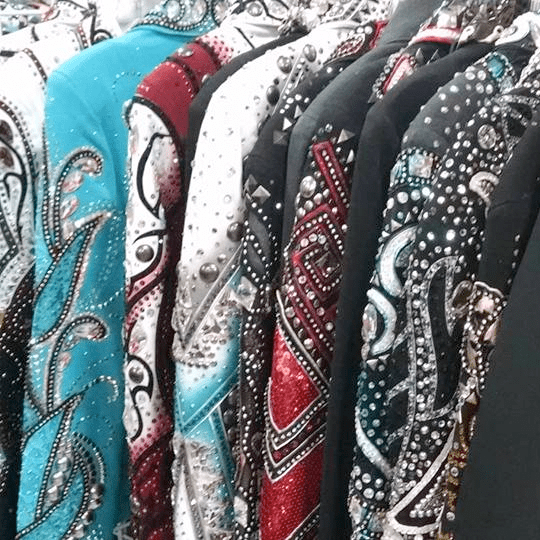“Care for your clothes like the good friends they are” – Joan Crawford
It is probably a safe bet that Joan Crawford was not talking about horse show apparel when she said this, but she didn’t have to be to drive the message home.
We all know the feeling we get when we slip on our favorite jacket that fits just right, or look in the mirror and a well-shaped hat is staring back at us. Every exhibitor strives to look their best in the show pen, but let’s face it, we don’t always take the best care of our “friends.”
Considering the fact that show clothes can be quite a hefty investment, it pays in dividends to know the proper way to care for them so they can be with you for years to come.
GoHorseShow reached out to the industry’s top professionals and talked to them about the best ways to take care of horse show apparel and what to do when something goes awry.
Let’s just say, they’ve got you covered from head to toe!
Hats
 Barbara Maitia of Barbara’s Custom Hats said when it comes to hats (especially felt) it is important to keep them in a cool, dry place as much as possible in order to maintain their “show” shape.
Barbara Maitia of Barbara’s Custom Hats said when it comes to hats (especially felt) it is important to keep them in a cool, dry place as much as possible in order to maintain their “show” shape.
“It’s hard for hats to keep their shape in a 100 degree trailer, especially when it’s humid,” she said. “Even though that is unavoidable at times, it’s best to store them in your house or tack room when at home, where it is a controlled environment.”
Maitia also shared something that a lot of folks do, not even realizing it has the potential to ruin their hats: keeping it in its original plastic bag.
“When your hat arrives in the plastic, it is clean,” she said. “However, once you wear your hat, it becomes dusty and when stored in plastic in extreme heat, the plastic will condensate and can bake the dirt and grime into the hat and damage your hat with mildew or stains caused by the sweating inside the bag. It also will create heat and cause the hat to lose its shape.”
 So once your hat arrives, ditch the plastic, it’s actually meant to be a one-time thing.
So once your hat arrives, ditch the plastic, it’s actually meant to be a one-time thing.
When it comes to standard care of your hat, Maitia said that the best thing to do is to use a brush to rid the hat of any dust that has collected after each wear and use a sponge for any spot treatment.
“If it gets something on it that is wet, you want to let it dry first before you try to do anything,” she said. “On a light colored hat, you can use cornstarch or powder on the spot to absorb it and then contact a professional right away.”
Stain treatment varies depending on what it is, so if that tragedy occurs, it is best to let a professional handle it and guide you through the steps.
And do not, under any circumstances, put a sweaty hat back in your hat box/can.
Maitia explained, “As you wear your hat and sweat in it, it expands. First, wipe out the inside with an alcohol wipe, and, then, let it sit on its crown for about five to ten minutes to give it a chance to air out. Then, adjust your hat in your hat can so it will keep its shape and will dry back to its original size.”
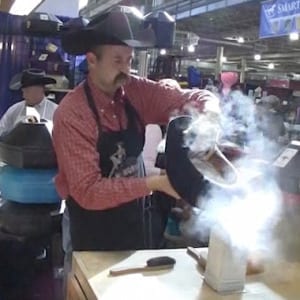 Things like comfort sweat bands that fit inside the hat are also helpful as well as refraining from spraying hairspray in your hat.
Things like comfort sweat bands that fit inside the hat are also helpful as well as refraining from spraying hairspray in your hat.
As far as the best way to store your hat, Maitia prefers hat cans that leave the hat right side up and are adjustable. “Hats tend to stay shaped better and travel best to the shows,” she said. “With double hat cans, store your straw hat on the bottom and the felt on top as the double cans are not watertight and the bottom hat will get damp and mildew. Straw hats tend to be more forgiving, but any hat can mildew if left wet and not aired properly.”
And because hats are stored so frequently, it is best to have it re-shaped and cleaned either right before or at every show.
“Today, there is usually a hat professional at all the bigger shows,” said Maitia. “Having your hat re-shaped and cleaned should be a part of your show routine, just like anything else you do in preparation for a show.”
Makeup
 Underneath your hat is that beautiful, smiling face the judges love to see. Okay, so maybe you’re not smiling, but you could be if you follow these makeup care tips from Darcy Reeve of Darcy Reeve Makeup Artistry.
Underneath your hat is that beautiful, smiling face the judges love to see. Okay, so maybe you’re not smiling, but you could be if you follow these makeup care tips from Darcy Reeve of Darcy Reeve Makeup Artistry.
Just like with hats (and as you will soon find out… with pretty much everything) heat and humidity are horrible for makeup, especially ones that can melt like lipsticks, soft eyeliners, etc.
Reeve said, “The best way to keep your makeup is in a cosmetic bag that is lined with plastic, so if anything breaks, leaks, or melts it helps keep everything protected.”
Reeve also suggests sticking to the cheaper drugstore makeup to keep in the trailer that you can use for touch-ups and keep your pricier makeup in a controlled environment, like back at the hotel.
 “I like to do my initial makeup in the morning at the hotel, and, then, I use my touch-up items that I have in the trailer throughout the day,” she said. “Also invest in a really good makeup setting spray, it is worth it to get your look to last all day.”
“I like to do my initial makeup in the morning at the hotel, and, then, I use my touch-up items that I have in the trailer throughout the day,” she said. “Also invest in a really good makeup setting spray, it is worth it to get your look to last all day.”
So what are the magical items you need to keep in the trailer?
Reeve says lipstick, mascara, and eyeliner are the three things you need to achieve a winning look.
“You can really get a good look with just those three things,” she said.
And how long should your makeup really last?
 Reeve revealed, “A good rule of thumb is to look at the cosmetic label. On the sticker, there should be a little graphic that looks like a jar with a number in it.” Our example to the left says 6M, so six months is what the manufacturer suggests. But according to Reeve, “Generally, you can double what that number says.”
Reeve revealed, “A good rule of thumb is to look at the cosmetic label. On the sticker, there should be a little graphic that looks like a jar with a number in it.” Our example to the left says 6M, so six months is what the manufacturer suggests. But according to Reeve, “Generally, you can double what that number says.”
As far as keeping your makeup brushes clean, Reeve said what she finds works best are the cheap hand soaps you find in hotels.
“You should clean your brushes every five to ten uses,” she said. “Once you’ve cleaned them, place the handle on an incline so the water can drip out of the brush and not gather inside where the glue is.”
 To get your brush back to that fluffy puff it once was, Reeve suggests swirling it around in a dry towel and then shaking it to help it return to its original shape.
To get your brush back to that fluffy puff it once was, Reeve suggests swirling it around in a dry towel and then shaking it to help it return to its original shape.
Finally, if you fly, save yourself the hassle and check your makeup in your luggage.
Never fear! Remember you have your touch-up items in the trailer if your luggage gets lost.
Western Jackets/Vests
 Author’s note: I have to admit, when I see an absolutely gorgeous jacket or vest covered in crystals and embellishments, I immediately think, “How do you take care of that?”
Author’s note: I have to admit, when I see an absolutely gorgeous jacket or vest covered in crystals and embellishments, I immediately think, “How do you take care of that?”
And the bottom line is, it really depends.
Custom clothing designers all have their own ways of creating and bringing pieces to life. Depending on the methods used to create them will determine just how you should take care of them.
However, both designers we spoke with, Lindsay Klempel of Silver Lining Custom Western Show Apparel and Sonia Vilandré of Vilandré Designer agreed that it is best to stay away from dry cleaning.
“I’ve seen bad things happen to the coating of the crystals with dry cleaning,” said Klempel.
Yet, all is not lost, as there is a very simple thing you can do to help keep your jacket or vest clean.
 “You can wipe down your jacket with a damp cloth to remove the dust after each time your wear it,” said Vilandré.
“You can wipe down your jacket with a damp cloth to remove the dust after each time your wear it,” said Vilandré.
Vilandré also recommended using a product called Stain Stoppers.
“These are very important to have inside your jacket,” she said, “and you can leave them in there for the whole show season. They really prolong the life of your clothes.”
Other tips Vilandré offered include wearing a shirt underneath your jacket and sticking Kleenex around the collar.
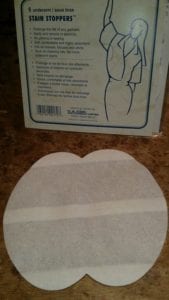 “If you wear a shirt underneath, the majority of your sweat will end up on the shirt instead of the jacket and the Kleenex prevents makeup stains on the collar,” she said, “which really hurts the resale value.”
“If you wear a shirt underneath, the majority of your sweat will end up on the shirt instead of the jacket and the Kleenex prevents makeup stains on the collar,” she said, “which really hurts the resale value.”
And speaking of stains, Klempel and Vilandré agreed that, when it comes to stains, it really is a case by case basis.
Klempel said, “Forever New is a product we use that works well, but your best bet is to contact your designer and see what they recommend. As a last resort, if the stain can’t be removed, you can usually tweak the design and cover it.”
For Klempel, the worst cases she sees (besides a dry cleaning fiasco) are when people try to wash an item that has deeply contrasting colors and fabrics (for example, a white base with a dark leather on top).
 “Bleeding is the biggest issue I see when it comes to ruining your clothes,” she said. “We really try to make our clothes washable and make sure the fabric is pre-washed so bleeding does not occur, but depending on a number of factors, this can be a challenge.”
“Bleeding is the biggest issue I see when it comes to ruining your clothes,” she said. “We really try to make our clothes washable and make sure the fabric is pre-washed so bleeding does not occur, but depending on a number of factors, this can be a challenge.”
For Vilandré, people who fail to store their jackets well and the unfortunate grease stain are the biggest offenders.
“It’s very important to hang up your jacket and let it dry before storing it,” said Vilandré. “It needs to air out before being zipped in a garment bag and it can’t be crowded. I highly recommend just one jacket per bag.”
 Vilandré also said a good sturdy hanger that is large enough and wide enough to fit your jacket is crucial, so it doesn’t lose its shape.
Vilandré also said a good sturdy hanger that is large enough and wide enough to fit your jacket is crucial, so it doesn’t lose its shape.
Klempel added, “Breathable garment bags are best and try to keep your clothes out of the trailer as much as possible. A controlled environment is best.”
There’s that phrase again, controlled environment.
Finally, if you have to fly with your show clothes in your suitcase, Klempel recommends rolling the jacket up using a towel so the stones don’t rub against each other and become damaged in flight.
Hunt Coats/Shirts
While English attire is a little more forgiving, there is still protocol that should be followed to get the most out of your wardrobe.
 Elizabeth “Spike” Brewer of Boo Yah Custom Clothing said, “Storing them in a trailer is fine unless they sit there more than a year. If you’re not actively showing, bring your clothes inside and hang in a closet. Trailers can get super hot and that isn’t good long term on a hunt coat.”
Elizabeth “Spike” Brewer of Boo Yah Custom Clothing said, “Storing them in a trailer is fine unless they sit there more than a year. If you’re not actively showing, bring your clothes inside and hang in a closet. Trailers can get super hot and that isn’t good long term on a hunt coat.”
Ideally, hunt coats and shirts should be clean (or relatively clean) before you store them.
“On hunt shirts, we suggest dry cleaning after every use to every few uses depending on weather and wear the shirt was subject to,” she said. “On hunt coats, it depends on how often 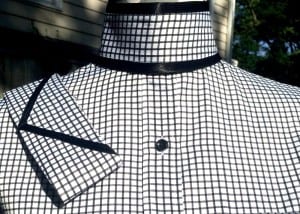 you wear it. If you wear it six times a year, then having it dry cleaned once a year would be fine. But if you are wearing it a couple weekends a month, we suggest having it cleaned every couple of months. It really depends on how much use they take and how dirty they get or if you sweat in them. If it’s a hot summer show and you were sweating a lot, we suggest having it cleaned. Leaving sweat in any item is not good for the fabric.”
you wear it. If you wear it six times a year, then having it dry cleaned once a year would be fine. But if you are wearing it a couple weekends a month, we suggest having it cleaned every couple of months. It really depends on how much use they take and how dirty they get or if you sweat in them. If it’s a hot summer show and you were sweating a lot, we suggest having it cleaned. Leaving sweat in any item is not good for the fabric.”
Brewer also recommends breathable garment bags and making sure the garment bag isn’t overcrowded.
Realistically, if you take good care of your hunt shirts they should last you anywhere from three to four years and coats can last even longer.
Chaps
 And this brings us to chap care.
And this brings us to chap care.
Valerie Heydinger of Showing Style by Valerie who specializes in custom chaps shared that well cared for chaps should last anywhere from five to ten years.
Her chaps are made from top grain leather and should never be thrown in the washing machine or dry cleaned.
“The best thing to do is to shake them out before you put them away,” she said. “You can also take an upholstery attachment with a vacuum and vacuum them going in an upwards motion. This really helps to pull the dirt out of the leather. Finally, use a suede brush to smooth them back out.”
 Chaps should always be stored in a breathable bag inside out.
Chaps should always be stored in a breathable bag inside out.
“Hang them on a good wood or metal hanger,” said Heydinger. “Something that won’t sag so they can keep their shape. The fringe should always hang on the hanger like it would on your leg to prevent kinking.”
Because of the sheer weight of chaps, Heydinger recommends sending them to the show in the trailer but guess what she recommends doing once there or when you are not showing?
You guessed it! Keep them in a controlled environment.
“Especially if you have silver on your chaps, it is really important to keep them in a bag, in a cool, dry place,” she said.
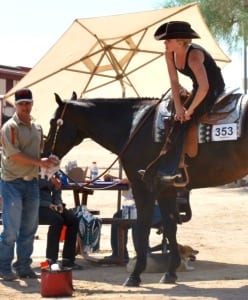 If you get mud on your chaps the best thing to do is let it dry first and then use a suede brush to work it out.
If you get mud on your chaps the best thing to do is let it dry first and then use a suede brush to work it out.
Lastly, Heydinger warns that carelessness is what ultimately wears out chaps faster than what it necessary.
“Not keeping your chaps clean, not hanging them up properly, not pulling them up while walking, and catching fringe in the zipper are all things I see and all of them can be prevented,” she said.
Summary
At the end of the day, your show wardrobe is an investment, just like your horse and your tack.
And just like we “baby” our horses and make sure our tack is clean and stored properly, we should also be kind to our clothes.
Because remember, they’re your friends!


